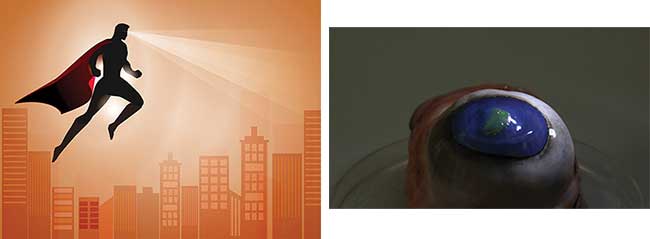In the classic comic-book narrative, one of Superman’s many powers was “heat vision,” an ability to store solar energy in his eyes and emit it in fiery optic blasts, which were graphically depicted as lasers. As with so much of yesteryear’s science fiction, the ability to shoot laser beams from one’s eyes has now come one step closer to reality.
Using semiconducting organic polymers, a research team at the University of St. Andrews in Scotland has developed an ultrathin membrane laser that could be used for new applications in security, biophotonics, and photomedicine.
The polymers are patterned using nanoimprint lithography, and the lasers are pumped optically. For pumping, one can use Q-switched, diode-pumped solid-state lasers, pulsed laser diodes, or pulsed LEDs.

(right) An ultrathin membrane laser on a contact lens on a cow eye. Courtesy of Jacquet/Panova, University of St. Andrews.
The new laser is flexible and approaches the fundamental limit in specific weight and thickness.
Malte Gather, a professor in the School of Physics and Astronomy at St. Andrews, told Photonics Media that because these membrane lasers have such low thresholds, they could be safely operated in a human eye or on a contact lens as an ocular laser.
“For instance, if someone had an iris scan taken to gain access to a restricted-access building, one would also read out the laser as additional verification,” he said. “Obviously, a tantalizing aspect of this application is that whoever wears these lasers sends a laser beam from their eyes every time the laser is activated.”
Gather and fellow St. Andrews professors Ifor Samuel and Graham Turnbull demonstrated ocular lasing using the cow eye as a model system.
“In ancient Greece, Plato believed that visual perception is mediated by ‘eye beams’ — beams actively sent out by the eyes to probe the environment,” Gather said. “Plato’s emission theory has of course long been refuted, but superheroes with lasers in their eyes live on in popular culture and comic books.”
The work at St. Andrews represents a milestone in laser development and points the way to how lasers can be used in inherently soft and ductile environments.
The team demonstrated that the devices were flexible and mechanically robust, even when attached to another object, finding that their optical properties did not change over the course of several months.
The researchers also were able to stick the ultrathin lasers onto banknotes, where they can be used as a security feature — similar to the holograms already used on paper currency, but more difficult to forge.
“This example exploits the fact that the lasers are rugged and that they can, in principle, be produced at very low cost and in very large numbers,” Gather said.
Flexible organic optoelectronics — in particular for displays, photovoltaics, and wearable sensors — is nearing large-scale commercialization. Prototype devices are already achieving staggering form factors and bending curvatures. The membrane laser now completes the family of ultrathin and ultraflexible organic optoelectronic devices.
The St. Andrews researchers will be working to reduce the lasers’ threshold even more while simplifying production and optimizing transfer onto untested objects.
Noncontact, all-optical authentication could come in the form of Superman’s heat vision — laser vision, in this case — and could possibly make the ultrathin membrane laser the most numerous type on our daily planet.